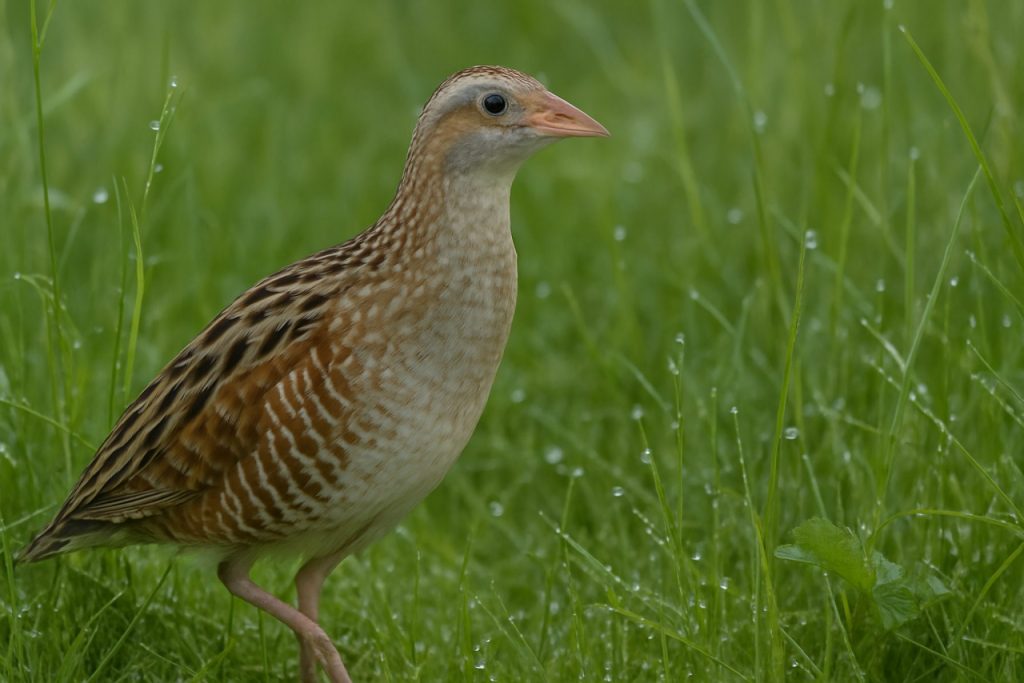
How Innovative Conservation Strategies Are Reviving Corncrake Populations. Discover the Challenges, Breakthroughs, and Future of This Elusive Bird’s Survival.
- Introduction: The Plight of the Corncrake
- Historical Decline and Causes
- Key Conservation Initiatives and Partnerships
- Habitat Restoration and Management Techniques
- Community Engagement and Farmer Collaboration
- Monitoring Success: Tracking Corncrake Recovery
- Challenges and Ongoing Threats
- Future Directions and Policy Recommendations
- Conclusion: Lessons Learned and the Road Ahead
- Sources & References
Introduction: The Plight of the Corncrake
The corncrake (Crex crex) is a secretive, ground-nesting bird once common across European meadows and grasslands. Over the past century, its populations have suffered dramatic declines, primarily due to changes in agricultural practices such as earlier and more frequent mowing, habitat loss, and the intensification of land use. These factors have led to the corncrake being classified as a species of conservation concern in many countries, and it is listed as “Least Concern” globally but “Near Threatened” or worse in several European regions International Union for Conservation of Nature (IUCN). The bird’s distinctive rasping call, once a familiar sound in rural landscapes, has become increasingly rare, symbolizing the broader decline of traditional farmland biodiversity.
Corncrake conservation efforts have become a priority for governments, NGOs, and local communities across its range. These initiatives focus on habitat management, agri-environment schemes, and public awareness campaigns to halt and reverse population declines. The plight of the corncrake highlights the complex relationship between modern agriculture and wildlife, emphasizing the need for sustainable land management practices that support both food production and biodiversity. As a flagship species for grassland conservation, the corncrake’s recovery is seen as an indicator of the health of wider ecosystems and the success of collaborative conservation strategies Royal Society for the Protection of Birds (RSPB).
Historical Decline and Causes
The historical decline of the corncrake (Crex crex) across Europe is closely linked to changes in agricultural practices and land use since the late 19th century. Traditionally, corncrakes thrived in hay meadows and grasslands managed with late-season mowing, which allowed chicks to fledge before fields were cut. However, the intensification of agriculture—particularly the shift to earlier and more frequent mowing, increased use of fertilizers, and conversion of meadows to silage or arable crops—has drastically reduced suitable breeding habitats. These changes led to widespread nest destruction and chick mortality, contributing to a dramatic population decline throughout Western and Central Europe by the mid-20th century (Royal Society for the Protection of Birds).
Additional factors exacerbating the decline include the drainage of wetlands, fragmentation of remaining habitats, and the loss of traditional small-scale farming. The mechanization of mowing, which increased the speed and efficiency of grass cutting, further reduced the chances for corncrake survival, as nests and flightless chicks were often destroyed before they could escape. In some regions, the use of pesticides and herbicides also diminished the abundance of invertebrates, a key food source for corncrakes (British Trust for Ornithology).
By the late 20th century, the corncrake had disappeared from much of its former range, surviving mainly in isolated pockets where traditional land management persisted. Understanding these historical causes has been crucial in shaping targeted conservation efforts aimed at reversing the species’ decline.
Key Conservation Initiatives and Partnerships
Key conservation initiatives for the corncrake (Crex crex) have focused on reversing population declines caused primarily by habitat loss and changes in agricultural practices. One of the most significant efforts is the implementation of agri-environment schemes that incentivize farmers to delay mowing and adopt corncrake-friendly land management. In the United Kingdom, the Royal Society for the Protection of Birds (RSPB) has led the Corncrake Recovery Programme, working closely with landowners to create and maintain suitable breeding habitats, such as tall grass and hay meadows, and to ensure that mowing is delayed until after chicks have fledged.
Internationally, the BirdLife International partnership has played a pivotal role in coordinating conservation actions across the corncrake’s European range, facilitating knowledge exchange and supporting national action plans. The European Environment Agency (EEA) and the Natura 2000 network have also contributed by designating protected areas and promoting sustainable land use policies. In Eastern Europe, organizations such as the Polish Society for the Protection of Birds (OTOP) have engaged in habitat restoration and public awareness campaigns.
These initiatives are often underpinned by partnerships between governmental agencies, NGOs, and local communities, ensuring that conservation measures are both scientifically informed and practically viable. Collaborative monitoring and research, supported by entities like the British Trust for Ornithology (BTO), provide essential data to adapt and refine conservation strategies, highlighting the importance of cross-sectoral cooperation in securing the future of the corncrake.
Habitat Restoration and Management Techniques
Habitat restoration and management are central to effective corncrake (Crex crex) conservation, as the species relies on specific grassland conditions for breeding and survival. The decline of traditional hay meadows and the intensification of agriculture have led to significant habitat loss, making targeted restoration efforts essential. Key techniques include delayed mowing, which allows corncrake chicks to fledge before fields are cut, and the creation of uncut refuge strips within meadows to provide shelter during harvesting operations. These measures have been shown to increase breeding success and chick survival rates Royal Society for the Protection of Birds.
Restoration projects often involve re-establishing species-rich grasslands through reseeding with native plants and managing grazing intensity to maintain suitable sward structure. Water management is also crucial, as corncrakes prefer damp, but not flooded, meadows. Collaboration with local farmers is a cornerstone of these efforts, with agri-environment schemes offering financial incentives for adopting corncrake-friendly practices. For example, the Corncrake LIFE project in Scotland has demonstrated the effectiveness of such partnerships in reversing population declines European Commission LIFE Programme.
Ongoing monitoring and adaptive management are necessary to refine these techniques, ensuring that restored habitats continue to meet the species’ ecological requirements. By integrating scientific research with practical land management, conservationists aim to create resilient landscapes that support sustainable corncrake populations into the future.
Community Engagement and Farmer Collaboration
Community engagement and collaboration with farmers are pivotal components of successful corncrake conservation efforts. The corncrake (Crex crex) relies heavily on traditional, low-intensity agricultural landscapes, making the involvement of local landowners and agricultural workers essential. Conservation organizations have developed agri-environment schemes that incentivize farmers to adopt corncrake-friendly practices, such as delayed mowing, leaving uncut field margins, and maintaining tall vegetation during the breeding season. These measures help protect nests and chicks from mechanical disturbance and predation.
Effective engagement often involves direct communication, workshops, and advisory visits, ensuring that farmers understand the ecological importance of the corncrake and the practical steps they can take. In countries like the UK and Ireland, targeted funding and support are provided through government-backed programs, such as those coordinated by NatureScot and National Parks and Wildlife Service. These initiatives not only benefit corncrakes but also enhance biodiversity and ecosystem services on farmland.
Community involvement extends beyond farmers to include local residents, schools, and volunteers, fostering a sense of stewardship and shared responsibility. Public awareness campaigns, citizen science projects, and local events help build support for conservation actions and ensure the long-term sustainability of corncrake populations. The collaborative approach has been recognized as a cornerstone of successful species recovery, as highlighted by Royal Society for the Protection of Birds (RSPB) and other conservation bodies.
Monitoring Success: Tracking Corncrake Recovery
Monitoring the success of corncrake conservation efforts is crucial for evaluating the effectiveness of implemented strategies and guiding future actions. Corncrakes (Crex crex) are notoriously elusive, making population assessments challenging. Conservationists primarily rely on systematic surveys of calling males during the breeding season, as their distinctive calls are the most reliable indicator of presence. These surveys are often conducted annually and use standardized protocols to ensure data comparability across years and regions. For example, the Royal Society for the Protection of Birds (RSPB) coordinates extensive monitoring in the UK, mapping territories and tracking population trends.
In addition to auditory surveys, advances in technology have enhanced monitoring capabilities. The use of automated recording devices and GPS tagging allows for more precise tracking of individual birds and their movements, providing insights into habitat use and migration patterns. Data collected through these methods inform adaptive management, enabling conservationists to adjust habitat management practices, such as mowing regimes and vegetation structure, to better support corncrake populations. The British Trust for Ornithology (BTO) also plays a key role in analyzing long-term data to assess population recovery and identify emerging threats.
Regular monitoring has demonstrated positive trends in some regions, with population increases linked to targeted agri-environment schemes and habitat restoration. However, continued vigilance is necessary, as corncrake populations remain vulnerable to changes in land use and climate. Ongoing tracking and data sharing among conservation organizations are essential for ensuring the long-term recovery of this iconic species.
Challenges and Ongoing Threats
Despite significant progress in corncrake conservation, numerous challenges and ongoing threats continue to impede the recovery of this elusive bird. The primary threat remains the intensification of agricultural practices, particularly the early mowing of hay meadows during the breeding season. This practice destroys nests and reduces suitable habitat, leading to high chick mortality rates. Efforts to encourage delayed mowing and the creation of uncut refuge strips have shown promise, but widespread adoption is hindered by economic pressures on farmers and the need for continued financial incentives and support (Royal Society for the Protection of Birds).
Habitat fragmentation and loss due to land-use change, drainage of wetlands, and urban expansion further exacerbate the situation. These factors reduce the availability of large, contiguous areas of tall vegetation that corncrakes require for breeding and cover. Additionally, climate change poses an emerging threat, potentially altering the timing of vegetation growth and the availability of suitable habitats (British Trust for Ornithology).
Another ongoing challenge is the limited public awareness and engagement in corncrake conservation, particularly outside key strongholds. Effective conservation requires collaboration between governmental agencies, conservation organizations, and local communities. Without sustained funding, policy support, and community involvement, the long-term prospects for corncrake populations remain uncertain (NatureScot).
Future Directions and Policy Recommendations
Looking ahead, the future of corncrake conservation hinges on adaptive management, cross-border collaboration, and robust policy frameworks. As agricultural intensification remains the primary threat to corncrake populations, future strategies must prioritize agri-environment schemes that incentivize wildlife-friendly farming. This includes delayed mowing, uncut field margins, and rotational management of grasslands, all of which have shown positive impacts on breeding success in pilot projects across Europe (Royal Society for the Protection of Birds).
Policy recommendations emphasize integrating corncrake conservation into national and EU-level agricultural policies, such as the Common Agricultural Policy (CAP). Enhanced funding for targeted habitat management and monitoring is essential, as is the development of performance-based payments to reward farmers for demonstrable conservation outcomes (European Commission). Additionally, transboundary cooperation is crucial, given the migratory nature of the species and the need for coordinated action across its range.
Future directions should also leverage technological advances, such as acoustic monitoring and satellite tracking, to improve population estimates and inform adaptive management. Public engagement and education campaigns can further bolster support for conservation measures, ensuring that local communities are active partners in protecting the corncrake. Ultimately, a combination of science-based policy, stakeholder collaboration, and sustained funding will be vital to reversing the decline of this iconic farmland bird.
Conclusion: Lessons Learned and the Road Ahead
The journey of corncrake conservation offers valuable lessons for the broader field of biodiversity protection. Key among these is the importance of collaborative, landscape-scale approaches that engage farmers, local communities, and policymakers. Initiatives such as agri-environment schemes, which incentivize wildlife-friendly mowing practices and delayed harvesting, have demonstrated measurable benefits for corncrake populations in several European countries (Royal Society for the Protection of Birds). These efforts underscore the necessity of integrating conservation objectives with agricultural productivity, rather than viewing them as mutually exclusive.
Another critical lesson is the value of robust monitoring and adaptive management. Long-term population surveys and habitat assessments have enabled conservationists to refine their strategies, respond to emerging threats, and allocate resources more effectively (British Trust for Ornithology). Furthermore, public awareness campaigns and cross-border cooperation have proven essential, given the migratory nature of the corncrake and the need for coordinated action across its range.
Looking ahead, the road to securing the future of the corncrake will require sustained funding, continued innovation in land management, and stronger policy frameworks at both national and international levels. The corncrake’s story illustrates that with targeted action and broad-based support, even species in steep decline can be given a chance to recover. These lessons are not only relevant for the corncrake but also serve as a blueprint for the conservation of other threatened farmland species.
Sources & References
- International Union for Conservation of Nature (IUCN)
- British Trust for Ornithology
- BirdLife International
- European Environment Agency (EEA)
- Natura 2000 network
- Polish Society for the Protection of Birds (OTOP)
- National Parks and Wildlife Service



